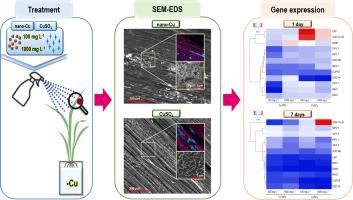NanoImpact ( IF 4.9 ) Pub Date : 2023-07-14 , DOI: 10.1016/j.impact.2023.100472 Magdalena Kusiak 1 , Magdalena Sozoniuk 1 , Camille Larue 2 , Renato Grillo 3 , Krzysztof Kowalczyk 1 , Patryk Oleszczuk 4 , Izabela Jośko 1

|
For safe and effective nutrient management, the cutting-edge approaches to plant fertilization are continuously developed. The aim of the study was to analyze the transcriptional response of barley suffering from Cu deficiency to foliar application of nanoparticulate Cu (nano-Cu) and its ionic form (CuSO4) at 100 and 1000 mg L−1 for the examination of their supplementing effect. The initial interactions of Cu-compounds with barley leaves were analyzed with spectroscopic (ICP-OES) and microscopic (SEM-EDS) methods. To determine Cu cellular status, the impact of Cu-compounds on the expression of genes involved in regulating Cu homeostasis (PAA1, PAA2, RAN1, COPT5), aquaporins (NIP2.1, PIP1.1, TIP1.1, TIP1.2) and antioxidant defense response (SOD Cu Zn, SOD Fe, SOD Mn, CAT) after 1 and 7 days of exposure was analyzed. Although Cu accumulation in plant leaves was detected overtime, the Cu content in leaves exposed to nano-Cu for 7 days was 44.5% lower than in CuSO4 at 100 mg L−1. However, nano-Cu aggregates remaining on the leaf surface indicated a potential difference between measured Cu content and the real Cu pool present in the plant. Our study revealed significant changes in the pattern of gene expression overtime depending on Cu-compound type and dose. Despite the initial puzzling patterns of gene expression, after 7 days all Cu transporters showed significant down-regulation under Cu-compounds exposure to prevent Cu excess in plant cells. Conversely, aquaporin gene expression was induced after 7 days, especially by nano-Cu and CuSO4 at 100 mg L−1 due to the stimulatory effect of low Cu doses. Our study revealed that the gradual release of Cu ions from nano-Cu at a lower rate provided a milder molecular response than CuSO4. It might indicate that nano-Cu maintained better metal balance in plants than the conventional compounds, thus may be considered as a long-term supplier of Cu.
Zn, SOD Fe, SOD Mn, CAT) after 1 and 7 days of exposure was analyzed. Although Cu accumulation in plant leaves was detected overtime, the Cu content in leaves exposed to nano-Cu for 7 days was 44.5% lower than in CuSO4 at 100 mg L−1. However, nano-Cu aggregates remaining on the leaf surface indicated a potential difference between measured Cu content and the real Cu pool present in the plant. Our study revealed significant changes in the pattern of gene expression overtime depending on Cu-compound type and dose. Despite the initial puzzling patterns of gene expression, after 7 days all Cu transporters showed significant down-regulation under Cu-compounds exposure to prevent Cu excess in plant cells. Conversely, aquaporin gene expression was induced after 7 days, especially by nano-Cu and CuSO4 at 100 mg L−1 due to the stimulatory effect of low Cu doses. Our study revealed that the gradual release of Cu ions from nano-Cu at a lower rate provided a milder molecular response than CuSO4. It might indicate that nano-Cu maintained better metal balance in plants than the conventional compounds, thus may be considered as a long-term supplier of Cu.
中文翻译:

缺铜大麦 (Hordeum vulgare L.) 对叶面施用纳米铜的转录反应:植物中铜负载与铜稳态基因变化之间的分子串扰
为了安全有效的养分管理,不断开发先进的植物施肥方法。本研究的目的是分析缺铜大麦对叶面喷施 100 和 1000 mg L -1 纳米颗粒铜 (nano-Cu) 及其离子形式 (CuSO 4 ) 的转录反应,以检查其补充效果影响。使用光谱 (ICP-OES) 和显微 (SEM-EDS) 方法分析了铜化合物与大麦叶的初始相互作用。为了确定铜细胞状态,铜化合物对参与调节铜稳态( PAA1、PAA2、RAN1、COPT5)、水通道蛋白(NIP2.1、PIP1.1、TIP1.1、TIP1.2)的基因表达的影响并分析暴露 1 天和 7 天后的抗氧化防御反应(SOD Cu Zn、SOD Fe、SOD Mn、CAT )。尽管随着时间的推移检测到植物叶片中铜的积累,但暴露于纳米Cu 7天的叶片中的铜含量比100 mg L -1的CuSO 4中的铜含量低44.5% 。然而,留在叶子表面的纳米铜聚集体表明测量的铜含量与植物中存在的真实铜库之间存在潜在差异。我们的研究揭示了基因表达模式随时间的显着变化,具体取决于铜化合物类型和剂量。尽管最初的基因表达模式令人费解,但 7 天后,所有铜转运蛋白在铜化合物暴露下均显示出显着下调,以防止植物细胞中铜过量。相反,由于低Cu剂量的刺激作用,水通道蛋白基因表达在7天后被诱导,尤其是100 mg L -1的纳米Cu和CuSO 4 。我们的研究表明,纳米铜以较低速率逐渐释放铜离子,提供了比 CuSO 4更温和的分子响应。这可能表明纳米铜比传统化合物在植物中保持了更好的金属平衡,因此可以被认为是铜的长期供应者。



























 京公网安备 11010802027423号
京公网安备 11010802027423号